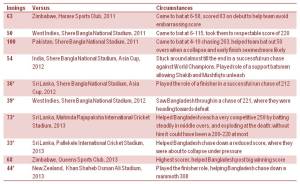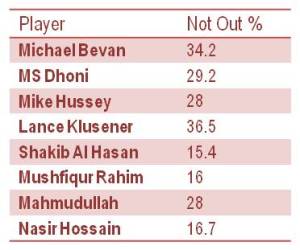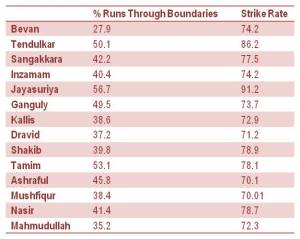By: Jeeshan Mirza
Imagine three distinct cricketing scenarios. You are chasing or batting first; there is a quick flurry of wickets and potential for collapse. Second, you are chasing a sizeable total; you have got off to a good start but you need to bat out the middle over’s steadily, keeping the run rate at manageable level, keeping wickets in hand so that you can have a go towards the end. Third, you are batting first, your top order has given you a steady platform, and you need to finish the last 20 over’s well to set a competitive total. If you were a captain or coach of a team who would you want in your batting lineup for such scenarios? Chances are Michael Bevan would make your shortlist, sometimes even ahead of the Tendulkar’s and Lara’s.
In his ten year career, Bevan has carved a unique niche for himself as an ODI finisher, a middle order lynchpin who won many a game for Australia with his determined and organized batting. His nerves of steel and never say die attitude bailed his team out of trouble on many occasions. While most wont categorize him amongst the greats, the Australian will always remain a benchmark as a finisher.
In his short career, Nasir Hossain has played many knocks which typify the role Michael Bevan used to played for Australia. In him, Bangladesh finally has a batsman who thrives under challenging circumstances and does it consistently-a rare trait among Bangladesh’s talented yet underperforming players. But 2014 has been a cruel year to Nasir. While he averaged 35 (ODI) in 2012, and 64 in 2013, he averages a disappointing 20 in 2014. Many feel Bangladesh’s woeful form this year could be attributed partly to Nasir’s poor run. In fact the Tigers have failed to close many games from favorable situations because of their inability to finish and handle pressure-something they have depended on Nasir to do. Batting collapses are also becoming common place.
Selected Nasir Hossain’s Bevan Type Knocks
Nasir’s predicament is not unusual in Bangladeshi cricket. Tigers have seen many a talent start off their careers with a bang, give fans great hope and expectation, only to lose form then slowly slide into oblivion. But in this case followers truly hope, Nasir doesn’t follow the path of his predecessor and instead work hard on his game and make a comeback.
A tenacious cricketer like Nasir will always be among the 20 percent, who influence 80 percent of Bangladesh’s outcomes. Thus getting him back in form should be a key concern for head coach Chandika Hathurusingha; who has a reputation as change agent. Being dropped from the test squad and first two ODI’s for the Zimbabwe series shouldn’t dishearten the Rangpur youngster. Rather he should seize this opportunity to re-evaluate his game and approach so that he can come back stronger. Here are a few ideas for Nasir Hossain and the coaching team to ponder about from the career of Michael Bevan.
Be There Till The End
Asia Cup 2014, Bangladesh Vs Afghanistan, Fatullah.
Nasir Hossain came to bat at 69/3 with the team in deep trouble chasing 255. Pressure performing in front of home crowd, a spirited Afghanistan team, the fear of losing to an associate-all these aspects troubled the Tigers. Situation was ripe for Nasir to play a heroic rescue knock-like he had done so often in the past. He was pretty much on track until the runs got clogged, and required run rate kept creeping up. Despite having the game well within reach with plenty of overs left, Nasir couldn’t take the pressure. So he decided to go on the offensive leading to his dismissal. At the end the Tigers fell short by 32 runs; but had he been around to partner Ziaur Rahman and the rest of the tail, the Tigers could have won.
Michael Bevan had a simple policy that defined his batting-he would always be there till the end. Bevan described his approach in an interview-“Even when it looks hard to score, it’s about being disciplined and carrying out your plans. One of my goals was to be there till the end. I figured that if I was there till the end we would win more matches than we lost. Of course, I didn’t score a run a ball every minute, but that was my goal”.
Bevan was indeed a master of being not out. Many critics said this was a selfish approach, and one that aided his batting average more than his team. Placing great value on his wicket, Bevan would avoid any high risk shots even if the situation demanded big hitting. But with him around till the last ball, Australia always had a better probability of winning.
If Nasir followed this approach against Afghanistan, he would have had 12 more over’s to help his team, instead of throwing it away in the 38th over. Even if he gave away dots, with wickets in hand and the teams experience would have tilted the game in Bangladesh’s favor. Despite batting at 6, 7 and 8, Nasir has a relatively low not out percentage indicating he often throws it away before the job is done.
Not Outs: Best Finishers & Bangladeshi Middle Order Batsmen
Rotate & Dictate
While not a natural big hitter, Bevan was perfectly capable of reaching the boundary if required. In a Rest of the World Vs Asia XI match played in Dhaka, the Australian hit 19 fours, and five sixes in a 185* knock from 132 balls at a strike rate of 140.2-a rare innings where he took the long handle approach (Not bad for a person who only hit 21 sixes in his entire 232 ODI’s). In an Australian shirt though, he preferred a more safe and responsible approach. He would constantly hit in the “V”, play to third man, nudge here and there for singles. A good eye and soft hands allowed him to pierce the gaps, or place between fielders for twos and threes. His good judgment and furious running between the wicket would allow him to put pressure on the field and convert ones to two’s and two’s to three. He owed his tireless running ability to high level of fitness and stamina-something he worked on religiously.
Once set, he would not hesitate punishing a bad delivery-but that too through placement and guile than power. He would rarely go after 50-50 and good line/length deliveries. Key difference is while a more conventional batsman would block or leave a few good deliveries to get eye in, Bevan would constantly work the gaps for singles. This way he could maintain high strike rates without the need to go for big shots.
% Runs Scored Through Boundaries: Selected ODI Greats & Bangladeshi Batsmen
Nasir Hossain has a limited yet effective batting technique. He is not blessed with the power, range and timing of some of his other colleagues. His batting is more to do with grit than perfection and finesse. A bottom handed hitter, Nasir preferred mode of scoring is slogging over mid wicket, long on, and slashing hard through point. Sadly this leads to most of dismissals as he lacks the muscle or grace. 63% of his dismissals are getting caught in the outfield most while trying to slog. Another 20% is caught behind by trying to cutting the ball hard.
If Nasir were to reduce his dependency on these two shots and instead focus on rotating the strike like Bevan, he would be a lot harder to dismiss. Fitness, athleticism, agility are some of Nasir’s greatest strengths. Considering this it would be wiser for him to build his innings by running hard between wickets, than playing high risk shots. And as we all know the longer Nasir remains at the wicket, the greater his probability of finishing well for the team.
A modern batsman who has adopted a similar approach is Fawad Alam. Once a bits and pieces all rounder, Fawad has transformed himself into an ODI weapon. His macho new avatar is matched by an unconventional stance, unorthodox hitting, and aggressive running which saps the energy out of fielders. Moin Khan, Jonty Rhodes, Robin Singh are some others who built their innings by hustling and being busy at the wicket.
Planning & Pressure
Failing to plan is planning to fail. This statement seems to make more sense when one watches the Bangladesh batsmen in action. Whether chasing or setting a score, Michael Bevan always had a plan in mind when coming to the crease, and this was executed efficiently. Even if wickets fell around him, or he slowed down he would never deviate from the plan. An analyst once wrote Michael Bevan had a calculator for a brain. He always knew how to pace an innings and finish a game.
Handling pressure was also one of Bevan’s specialties. He thrived in batting with lower order batsmen rescuing the team from precarious situations. He mentioned in an interview “Pressure is the thing that makes people make mistakes and costs matches. I always try to say to myself that we are going to lose some matches. So I never try to put too much pressure on myself.”
From his very first game, Nasir has stood out from his colleagues because of his ability to stay calm and composed. A player who shows little emotion, Nasir does not get flustered or overawed against more illustrious opposition. His performance in Asia Cup 2013 best demonstrated such characteristics. In almost every innings in that tournament he was sent with a plan which he executed well. In the past, even when the best like Mushfiq, Shakib and Tamim capitulated under pressure, Nasir batted with the tail to steer the team to safer waters.
But things have changed in 2014. Lack of runs have badly dented his confidence, fear of being dropped hasn’t help either. The Nasir Hossain who now comes to the pitch seems indecisive, panicky, nervy and prone to playing rash strokes.
The coach and captain must step in and remind Nasir of the game changing knocks he has played in the past. All Nasir needs is a bit of confidence and clarity on the role that is expected of him.
Recovery Road
All good players go through bad phases in their career. The very best learn from those difficult circumstances and come back stronger. Now it is up to Nasir Hossain to realize his limitations, and try to work around them.
Nasir’s best knocks are nothing less or short than the type of knocks Bevan, Dhoni, played for their teams. The ability to play under pressure when the ship is sinking is a rare talent which not everyone possesses. Technical deficiencies are not holding him back, it is simply his approach to the game. The selectors must keep faith in him. Most importantly the captain and coach must clearly clarify the role they expect him to play.
An in form Nasir Hossain will always put Bangladesh into more favorable situations. The lack of a finisher means the Tigers will keep losing from winning positions or rely on the mercy of opposition to create upsets. But with a guy like Nasir, Bangladesh will always be a better and more complete side.
The author is an ardent Bangladeshi cricket fan based out of Colombo, Sri Lanka. He welcomes feedback at jeeshan2000@gmail.com



